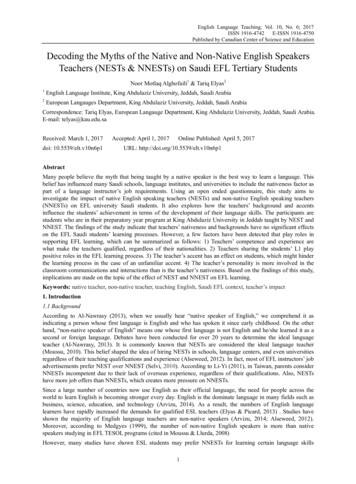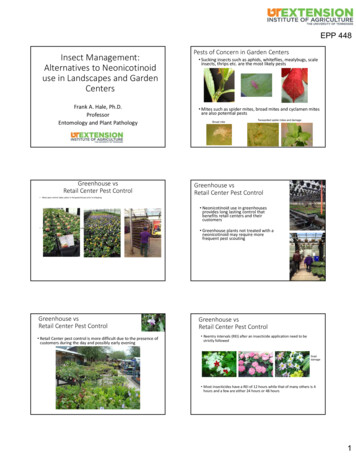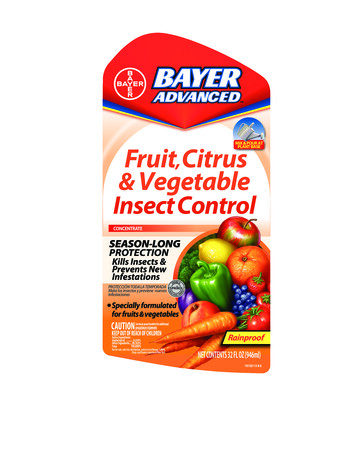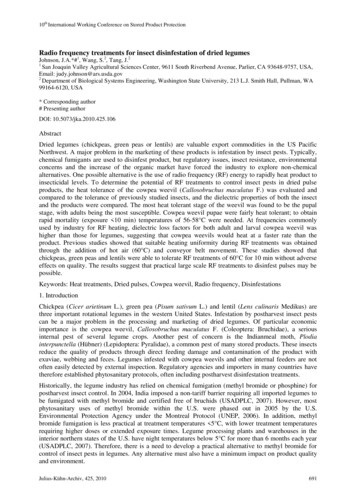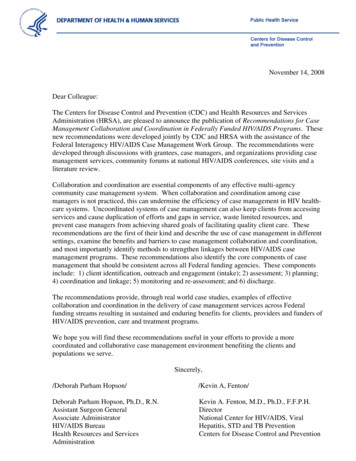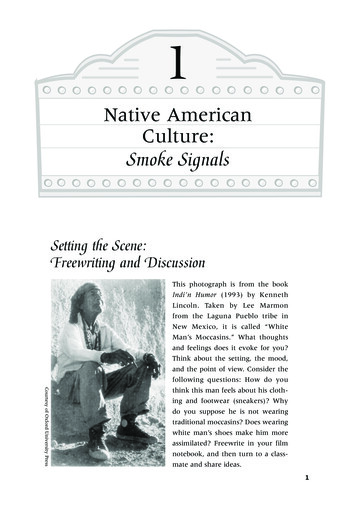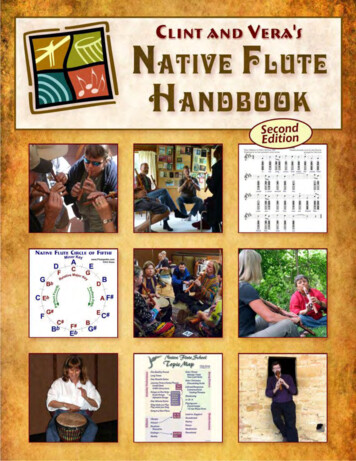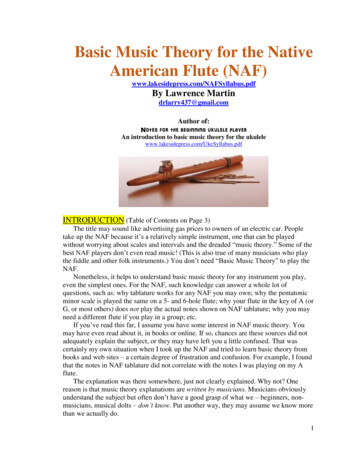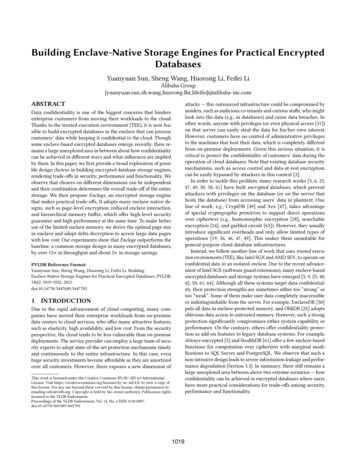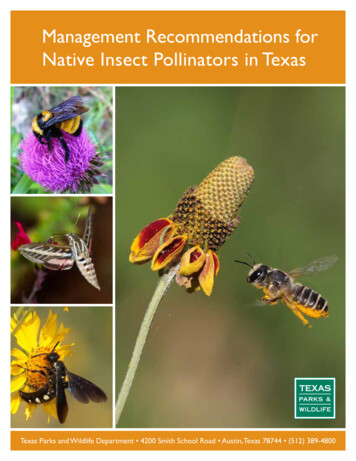
Transcription
Management Recommendations forNative Insect Pollinators in TexasTexas Parks and Wildlife Department 4200 Smith School Road Austin, Texas 78744 (512) 389-4800
Management Recommendations forNative Insect Pollinators in TexasDeveloped byMichael Warriner and Ben HutchinsNongame and Rare Species ProgramTexas Parks and Wildlife DepartmentAcknowledgementsCritical content review was provided by Mace Vaughn, Anne Stine, and Jennifer Hopwood,The Xerces Society for Invertebrate Conservation and Shalene Jha Ph.D., University ofTexas at Austin. Texas Master Naturalists, Carol Clark and Jessica Womack, provided theearly impetus for development of management protocols geared towards native pollinators.Cover photos: Left top to bottom: Ben Hutchins, Cullen Hanks, Eric Isley, Right: Eric IsleyDesign and layout by Elishea Smith 2016 Texas Parks and Wildlife DepartmentPWD BK W7000-1813 (04/16)In accordance with Texas State Depository Law, this publication is available at the Texas State PublicationsClearinghouse and/or Texas Depository Libraries.TPWD receives federal assistance from the U.S. Fish and Wildlife Service and other federal agencies andis subject to Title VI of the Civil Rights Act of 1964, Section 504 of the Rehabilitation Act of 1973, Title II ofthe Americans with Disabilities Act of 1990, the Age Discrimination Act of 1975, Title IX of the EducationAmendments of 1972, and state anti-discrimination laws which prohibit discrimination the basis of race,color, national origin, age, sex or disability. If you believe that you have been discriminated against in anyTPWD program, activity or facility, or need more information, please contact Office of Diversity and InclusiveWorkforce Management, U.S. Fish and Wildlife Service, 5275 Leesburg Pike, Falls Church VA 22041.
Background InformationPollination is a critical ecosystem service that helps to maintain the ecological integrity of native plantcommunities. The majority of flowering plant species require animal-mediated transportation of pollengrains among receptive flowers to facilitate pollination and produce viable seed. Potential pollinatorsinclude ants, bats, bees, beetles, butterflies, flies, hummingbirds, moths, and wasps.Pollination and the formation of viable seed are critical for the perpetuation of native plant populations. Inaddition, the berries, nuts, pods and other fruit produced through pollination can serve as important foodresources for a diverse array of animals including birds, insects, reptiles, and mammals. Because pollinatorsplay such a significant role in plant reproduction as well as production of plant-based foods for otherspecies, practices that benefit native pollinators should be a component of any wildlife management plan.In Texas, as in most of the world, insects serve as the primary pollinators of the majority of native plantsand are the most important pollinators of agricultural crops. As discussed below, some insect groups aremore efficient and effective pollinators than others. These species are ideal focal targets to support overallnative pollinator diversity. Implementation of practices to enhance pollinator habitat will also benefit agreat number of species dependent upon diverse native plant communities.Leafcutter bee. Michael Warriner.1
Targeting Effective and Efficient PollinatorsAnimal-pollinated plants generally entice potential pollinators through showy flowers that offer rewards inthe form of nectar and pollen. Nectar, composed of sugars and other compounds, is an important energysource for many flower-visiting species. Some flower-visiting animals, such as butterflies, hummingbirds, andmoths, visit flowers only to feed on sugar-rich nectar. Pollen represents a source of protein and fats for asmaller subset of flower-visitors. Bees, while also feeding on nectar, are one of the few flower-visitorsthat purposefully forage for pollen, collecting and transporting it as a food source for their young.Native solitary bee carrying large amounts of pollen. USGS Bee Inventory and Monitoring Lab.Bees rely upon pollen as a protein source for their developing larvae. Specialized pollen-collecting hairs orother pollen-carrying structures on their bodies enable adult female bees to gather and transport largeamounts of pollen to their nest. Much of this gathered pollen will be consumed by their larvae, but beesare vigorous foragers and inadvertently drop or rub pollen off of their bodies as they move from flowerto flower.During a single day, a female bee may visit several hundred flowers, transferring pollen along the way.Additionally, bees have floral preferences and may concentrate their efforts during any given foraging tripon a certain species of flower in bloom. By focusing in on a single species or subset of species, femalebees deliver the right pollen to the right flower. Compared to those animals that lack dedicated pollencarrying structures or that don’t forage specifically for pollen, bees are much more efficient and effectiveat transferring pollen among flowers.Crafting a wildlife management plan that meets the needs of native bees is ideal for maintaining arobust population of native flowering plants on your property. At the same time, a wide variety of otherpollinators will be supported by management activities that provide the food resources needed by bees.2
Native vs. Non-Native BeesOver 3,500 native bee species and roughly 30 non-native bee species have been recorded from NorthAmerica north of Mexico. The European honey bee (Apis mellifera) is the most familiar and well-knownnon-native bee species in North America. Brought here in the early 1600s, honey bees now occur nearlycontinent-wide in the form of feral and managed colonies. The honey bee’s status as a managed andeasily transported insect has made this single bee species the most important pollinator of dozens of U.S.agricultural crops valued in the billions of dollars annually.European honey bee. John Severns.While certainly important from an agricultural perspective, honey bees are not a component of NorthAmerica’s native natural communities and could negatively impact those systems through competition forforaging resources, disease transmission to native bees, or other means. Beyond native pollinators, thereis evidence that some cavity-nesting birds compete for nest sites with feral honey bee colonies, to theirdetriment. Due to its non-native status and potential impacts on natural communities, the honey bee ismore appropriately managed as a semi-free ranging agricultural animal and not as a component of nativewildlife or within the context of a wildlife management plan.The number of native bee species in Texas vastly outnumbers non-native species. Texas’s native bees displayan incredible range of shapes, size, colors, and lifestyles. An accurate tally of the native bees that occur inTexas is not yet available but a conservative estimate suggests that over 700 native bee species occur here.Native bees are generally the most efficient and effective pollinators of native plants and thus critical tothe maintenance of Texas’ natural communities. In fact, many native plants can only be pollinated by nativebees or other native pollinators. Native bees are also very effective pollinators of many agricultural corps.Several crops, including blueberries, melons, squashes, and tomatoes, are more effectively pollinated bynative bees than the non-native honey bee. The annual value of native bee pollination to U.S. agricultureis estimated to be 3 billion.3
Social and Solitary Native BeesMany members of the general public are fearful of bees and other stinging insects. This fear is based on thedefensive behavior some social insects display when their colonies are disturbed. Truly social insects livein cooperative groups composed of a queen and her daughter workers. Colonies of bald-faced hornets(Dolichovespula maculata), European honey bees, paper wasps (Polistes), and yellowjackets (Vespula) are wellknown for issuing contingents of workers to ward off perceived threats with venomous stings. Social beesand wasps are most defensive at the nest site where they have much to protect (queen, eggs, larvae,stored food). While foraging among flowers for food, social bees and wasps are often oblivious to thepresence of humans or simply fly away when disturbed.Southern plains bumble bee. Jessica Womack.Social bees and wasps can be recognized by their mass aggregations and workers streaming to and froma single, defined nest site. Colonies of these species should be treated with respect. Minimize traffic,mowing, or other vibration-creating activities close to the nest. Because of their benefit to nativeplant communities, social bee and wasp colonies should be conserved unless they cause direct damageby their nesting activity or constitute a stinging threat. If a colony of social bees or wasps must beexterminated it is advisable to use the services of a licensed pest control operator. Some honey beekeepers will provide removal services for this insect. For more information on honey bee removal seeTexas Apiary Inspection Service: Bee Removal.4
Only a very small number of native bees in Texas are social. The largest and most familiar are bumblebees (Bombus). Their black and yellow bodies are easy to recognize as they buzz from flower to flower. Ninebumble bee species have been recorded from Texas. Bumble bee diversity is greatest in eastern Texas anddeclines westward across the state. While bee diversity overall tends to peak in arid regions, bumble bees inNorth America increase in diversity at higher latitudes and elevation.Approximately 90% of bees native to Texas are solitary species. Unlike social bees, solitary bee femalesestablish and provision nests on their own with no assistance from other individuals. There is no division oflabor into queens, workers, or drones. Because nests are established by lone females, these bees will notattempt to defend their nest sites through aerial sting attacks. If a female solitary bee dies, then she couldlose her entire reproductive effort because there is no colony to provision her young in her absence. Malebees do not collect pollen to provision young or otherwise assist in raising offspring.Mason bee. Jessica Womack.Even though they do possess stingers, female solitary bees tend to flee or hide when disturbed at thenest. The nest sites of native solitary bees can be approached without fear of defensive attack. Make sureyou know the difference between social and solitary bee species in your area, though, to ensure safety.Always first observe nests of bees and wasps from some distance in the case they may be a social species.Stings from native solitary bees typically only occur if an individual bee is trapped in clothing or grasped inhand. Artificial nest structures for these bees can be placed next to areas of human activity.Solitary bees tend to be less frequently observed than their social relatives. They may even be hard toidentify as a “bee” given their wide range of shapes, sizes, and color patterns. Less well-known solitarybees such as large carpenter bees (Xylocopa), leaf-cutter bees (Megachile), mason bees (Osmia), miningbees (Andrena), squash bees (Peponapis), sunflower bees (Diadasia), and sweat bees (Agapostemon) areresponsible for a substantial amount of pollination in agricultural and ecological systems.5
Simple NeedsNectar and pollen are the only food source for native bees. Most species benefit from sites with a diversearray of native herbaceous and woody plants which provide a succession of flowers from spring into earlyfall. While some native bees may be active as adults for only short periods of time (a few weeks to a month),bumble bees require a near continuous source of nectar and pollen from early spring, through summer, intofall to complete colony development. Additionally, different bee species have different active periods duringthe year. Some bees, like Andrena species, are primarily active in the spring. Others, like Melissodes species,are active in the summer or fall. A gap in floral availability could cause a site to lose its complement ofpollinators which forage in that window. Flowers across the growing season are needed to support the fullcomplement of native pollinators.A secondary benefit of richnative plant diversity is increasedavailability of suitable egg-layingsites (host plants) for butterfliesand moths. Host plant preferencesvary greatly by species withsome butterfly and moth speciesrequiring very specific plants foregg-laying. The monarch butterfly(Danaus plexippus) and its welldocumented dependence onmilkweed (Asclepias) species isa classic example. Many otherbutterfly and moth species are farless specific and able to lay theireggs on a wide range of plantspecies. Consequently, increasingthe number of native plants in anarea can increase the number ofbutterfly and moth species thatmay be attracted to a site.Along with nectar and pollen fromflowers, native bees require suitableplaces to nest. Bees are consideredGreat purple hairstreak. Cullen Hanks.central place-foragers, meaningthat females conduct all of theircollecting trips for food from one central point on the landscape, their nest site. The nesting habits of nativebees can be broadly classified into three categories, ground-nesters (e.g., mining bees), tunnel nesters (e.g.,mason bees), and cavity nesters (e.g., bumble bees).Most native bees are ground-nesters, nesting in self-made burrows in bare soil. Tunnel nesters use holes leftby wood-boring beetle larvae in standing dead trees or chew their own cavities into dead wood or pithystems. A small percentage of bees (e.g., bumble bees), are social colony builders and nest in pre-existingunderground cavities (rodent burrows), within clumps of grass thatch, or in other insulated above-groundcavities.6
Identify and Protect What You Already HaveOnce you are familiar with the basics of what native bees need, the next step is determining if thoseresources exist on your property. Survey your property to evaluate if it already contains diverse patches offlowering herbaceous plants or stands of flowering shrubs and trees. Observe these patches or stands atdifferent times of day to see which plants are most heavily used by bees and other flower-visitors. Patchesof good-quality native flowering plants will be important sites to manage and protect within the framework of your property’s wildlife management plan.Existing nest resources will be a little harder to recognize than patches of flowering plants, but generalnesting habitats across a property can be roughly demarcated. Brush piles, downed wood, and standingdead trees represent potential natural nesting sites for tunnel nesting bees and bumble bees. Well-drained,sparsely vegetated patches of bare ground are preferred nesting habitat for many ground-nesting bees.Sweat bee emerging from nest. Eric Jacob.Ground-nesting bee activity can be difficult to observe because there is often little above-ground evidenceof the nests. However, if you are patient, you can sometimes observe female bees perched just inside theentrance to their nest, preparing to depart for a foraging run, or flying low over the ground searching fortheir nest entrances or mates. Ground nest entrances may resemble small ant mounds, with small piles ofexcavated earth around the hole, or a cluster of holes in the ground. They can range in size from 1/8 to1/2 inch in diameter, depending on the species. Bumble bees, on the other hand, do not dig their own nestsbut rather take up residence in abandoned rodent burrows or tussocks of grass in areas of thick herbaceousvegetation.Refer to The Xerces Society for Invertebrate Conservation’s Pollinator Habitat Assessment Form and Guide:Natural Areas and Rangelands to assess resources already present on your property, identify shortfalls, andpotential management needs.7
Adapt Current Management PracticesManagement practices, such as grazing, haying, and prescribed burning can limit woody plant encroachment,suppress non-native plants, and enhance native herbaceous plant diversity. However, these practices shouldbe implemented with the needs of native bees and other insect flower-visitors in mind as these practiceshave the potential to reduce or even completely eliminate floral resources, host plants, and nest sites.Certain management activities, if performed without care, can even harm pollinators and extirpate themfrom a site.When applying any management practice to a property it is critical to avoid treating an entire area inone season. A site that is burned, grazed, or hayed in its entirety in the dormant season will virtuallyeliminate those native bees that are overwintering in dry stalks, stems, and twigs. Some pollinators, suchas some species of butterflies, beetles, and flies overwinter in leaf litter and may be severely impacted byprescribed burns during the winter. Implementing these same practices to an entire site during the growingseason will remove nearly all flowers (nectar and pollen resources), potential nest sites, and host plants ofbutterflies and moths. If the surrounding area does not support populations of these bees and butterflies,disrupting the entire site at one time could cause you to lose pollinator species diversity.As a general rule, only treat up to 30% of a site at a time. For example: if you have a 12-acre, flower-rich haymeadow, only cut four acres in a single year and rotate through the remaining acreage over the followingyears. Untreated areas of the property will provide much needed food and nest sites and also serve ascritical refugia for species to recolonize the managed portion as it recovers the following year.Non-native grass monoculture (left) versus flower-rich, good quality bee habitat (right). Michael Warriner.8
The prescriptions below are general guidelines to maintain areas with existing native insect pollinator habitaton your property. If you are actively restoring a property to a more natural state, you may find the need toconduct management outside of the time periods suggested below. Prescribed burns should be conducted from fall into early spring. Avoid burns during the growingseason. Allow sufficient time for recovery between burns (burn cycle will vary by ecoregion) forthatch to accumulate and enable insect populations in burned sections to recover. Cattle grazing should be designed to protect and enhance areas containing nectar and pollenresources. Grazing intensity may be low to high depending upon the goals of your managementplan. Low intensity grazing tends to promote selective consumption of grasses and the morepalatable forbs, while high intensity grazing leads to uniform consumption of plant matter acrossthe landscape. Low intensity, short duration grazing from fall into early spring may have theleast impacts on native bee resources. High intensity, short duration grazing may be needed inrestoration efforts to increase seed germination or control non-native grasses. Avoid grazing withgoats or sheep as these feed more heavily on important nectar and pollen-bearing wildflowers. Haying should be restricted to fall through early spring to maximize availability of flowering plantsfor native bees. Avoid haying too low, as bumble bees often nest in ground-level accumulationsof thatch. Instead, maintain a minimum cutting height of six to eight inches. If haying must beconducted during the growing season, leave blocks or strips uncut to retain some stands of flowersand nest sites. Avoid the application of chemical fertilizers, as these can increase the growth of nonnative grasses and weeds to the detriment of annual and perennial wildflowers. Tilling or deep disking in areas that host aggregations of ground-nesting bees should be avoided.Tilling and disking also may promote the invasion or germination of non-native plants.Try to vary the techniques applied to
foraging resources, disease transmission to native bees, or other means. Beyond native pollinators, there is evidence that some cavity-nesting birds compete for nest sites with feral honey bee colonies, to their detrim
